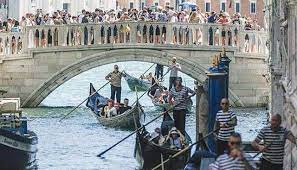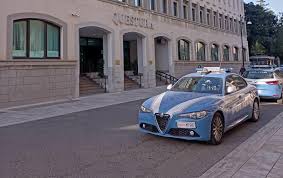Italy: Venice to ban large tourist groups and loudspeakers

Venice: Venice is to ban loudspeakers and tourist groups of more than 25 people, in a bid to ease the impact of mass tourism on the Italian city.
The new rules will come into effect from June, the city said in a statement.
The use of loudspeakers has been banned as they can “generate confusion and disturbances”, it added.
Over-tourism is widely recognised as an urgent issue for the canal city, one of the most visited places in Europe.
In September, Venice approved the trial of a €5 (£4.30; $5.35) fee for daily visitors.
Elisabetta Pesce, the official with responsibility for the city’s security, said the latest policies are “aimed at improving the management of groups organised in the historic centre”.
The city is just 7.6 sq km (2.7 sq miles) in size but it hosted almost 13 million tourists in 2019, according to the Italian national statistics institute. Numbers of visitors are expected to exceed pre-pandemic levels in the coming years.
More and more residents in Venice are choosing to leave, fearing that tourists could overwhelm the historic island city.
Citizen associations in Venice launched studies in April to monitor how many beds are available for both tourists and residents in the city.
According to the most recent update from one of them, Ocio, the number of beds for tourists has risen to more than 50,000 – exceeding those available to locals.
In July, experts from Unesco said the city should be added to a list of world heritage sites in danger, as the impact of climate change and mass tourism threaten to cause irreversible changes to it.
The UN cultural body’s experts blamed the Italian authorities for a “lack of strategic vision” to solve the problems faced by one of Italy’s most picturesque cities.
Ultimately, Unesco did not add Venice to the list. Italian Culture Minister Gennaro Sangiuliano said Unesco had recognised attempts to address the island’s problems via an anti-flooding system and by the approval of the entry fee for tourists.
In 2021, large cruise ships were banned from entering the historic centre of Venice via the Giudecca canal after a ship crashed into a harbour.
Critics had also argued that the ships were causing pollution and eroding the foundations of the city, which suffers from regular flooding.
Venice is not unique among Italian and European hotspots in trying to address problems related to tourism.
In nearby Florence, authorities have banned new Airbnbs and short-term holiday lets in its historic city centre.
In 2019, the Italian capital Rome introduced fines aimed at tourists – barring men from being shirtless in public, banning so-called “love padlocks” from being attached to bridges and cracking down on messy foods around famous tourist attractions like the Trevi Fountain.
The picturesque fishing village of Portofino, on the Italian Riviera, has brought in no-waiting zones in photogenic spots, with Instagram-happy tourists facing fines of up to €275 (£238) if they linger too long for that perfect selfie.
Away from Italy, Athens in Greece capped visitor numbers at the iconic Acropolis to 20,000 a day, to try to reduce damage to the ancient temple complex.
And in the Austrian Alps, the town of Hallstatt – said to have inspired the setting of Disney film Frozen – has built wooden barriers to block views in popular spots for a lakeside snap, on top of capping the number of tourist buses and cars entering the area.





